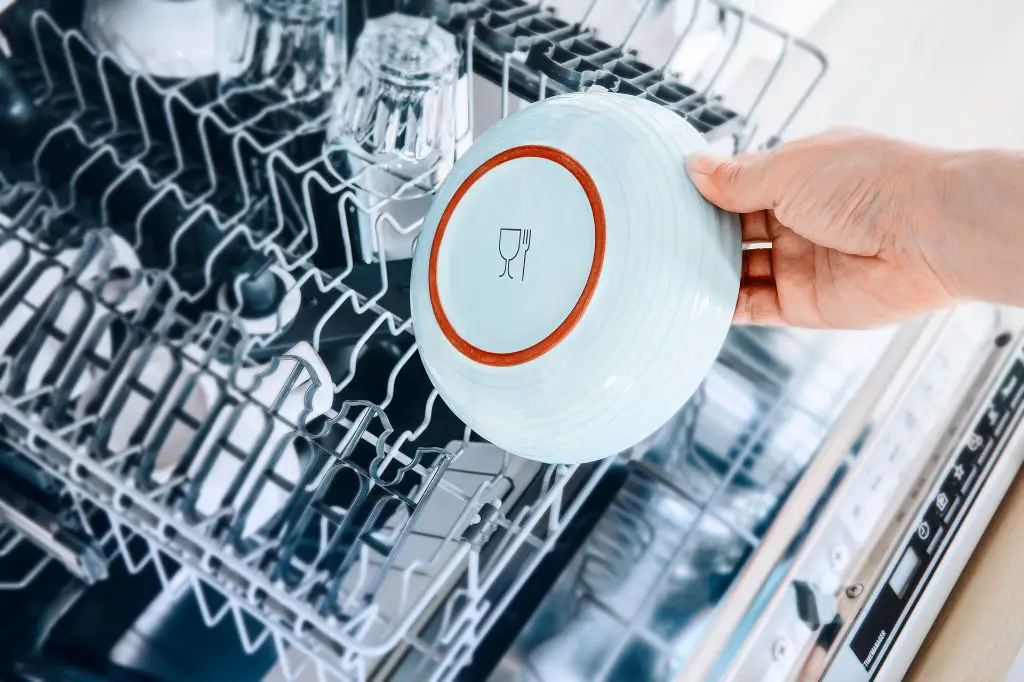What Does Not Dishwasher Safe Symbol Look Like?
Introduction
The not dishwasher safe symbol is an important icon to recognize when washing dishes and glassware. This article will provide a brief overview of what the symbol looks like, where you might see it, the meaning behind the symbol, reasons for the warning, proper care instructions, potential effects of dishwashing, exceptions, and related symbols.
Description of the Symbol
The most common image used for the not dishwasher safe symbol is a glass inside a circle with a diagonal line or X drawn across it. This universal symbol indicates that the item should not be placed in the dishwasher. According to Homemade Simple, the image represents “a glass with a slash through it, [which] typically means that the item is not dishwasher safe.”

Maytag notes that “a circle with an ‘X’ drawn through it…signifies that [an] item should not be cleaned in the dishwasher.” So whether it’s a glass, plate, or other tableware, a circle with a diagonal slash or X is universally understood to mean “do not put this in the dishwasher.”
Where You Might See the Symbol
The not dishwasher safe symbol is commonly found on product packaging, tags, and labels. You’ll often see it on household items like:
- Wooden cutting boards, utensils, and cookware
- Cast iron pans and skillets
- Handmade pottery and ceramic dishes
- Antique or vintage dinnerware
- Crystal glasses and vases
- Aluminum pots and pans
- Copper mugs and bowls
- Decorative kitchen accessories
- Plastic containers not designed for high heat
Checking packaging or tags before placing items in the dishwasher can help avoid damage. If you see the not dishwasher safe symbol, hand washing is recommended.
Meaning of the Symbol
The not dishwasher safe symbol indicates that an item should not be cleaned in a dishwasher. According to Finish Dishwashing, “Typically, the dishwasher safe symbol looks like a square box with some plates or glasses (or both) inside it.” In contrast, the not dishwasher safe symbol will have a cross or ‘X’ drawn across this square box symbol. This shows that while some items are safe for the high heat and harsh detergents in a dishwasher, the item marked with the not dishwasher safe symbol should not be subjected to dishwasher cleaning.
The main purpose of the not dishwasher safe symbol is to warn consumers that the item could become damaged if cleaned in a dishwasher. Putting an item marked not dishwasher safe into a hot wash cycle may cause it to warp, melt, discolor, or deteriorate prematurely. Heating plasticware too hot can cause it to leach chemicals. The harsh spray of water in a dishwasher may also fade decorative patterns painted on dishware over time. By clearly labeling items not suitable for the dishwasher, manufacturers help consumers avoid easily preventable damage.
Reasons for the Warning
Certain materials and products should not be placed in the dishwasher because they can become damaged by the high heat, harsh detergents, and forceful water pressure inside a dishwasher. According to experts at Whirlpool, materials like cast iron, enameled cast iron, non-stick coatings, aluminum, and certain plastics are often not dishwasher safe [1].
The high temperatures inside a dishwasher can cause cast iron and enameled cast iron cookware to rust or have the enamel coating chip and peel away over time. Non-stick surfaces can deteriorate and aluminum items can become dulled or discolored [1].
Additionally, the strong water jets and harsh detergents strip away the seasoning on cast iron that helps prevent rusting and sticking. They can also degrade the non-stick surface, according to Martha Stewart [2].
Certain plastics and acrylics can become brittle and crack over repeated dishwasher cycles. The heat and chemicals weaken the material over time.
Proper Care
Items with the not dishwasher safe symbol should not be placed in a dishwasher, as the high heat and harsh detergents can damage many materials. Instead, proper care for these items generally involves hand washing and spot cleaning.
For wood items like cutting boards and utensils, it is best to hand wash with warm water and mild detergent. Avoid soaking wood, and dry thoroughly after washing. Oiling wooden items regularly will also help maintain their finish and integrity. For items with decorative painted details, gently hand wash and avoid abrasive scrubbing to prevent chipping. Delicate glassware and crystal should also be hand washed in warm water to prevent cracking or clouding from high heat.
Ceramics marked not dishwasher safe are prone to fading of decorative details with repeated dishwasher use. These should be hand washed as well. Cast iron can rust when subjected to dishwasher detergents, and should be washed by hand, dried thoroughly, and re-seasoned after each use. Non-stick pans and bakeware will lose their coating, so wash with non-abrasive tools and avoid the dishwasher.
For spot cleaning stuck-on food, gently scrub with a soft sponge and warm water. Avoid abrasive cleaners or scouring pads which could damage surfaces. Always refer to the manufacturer’s care instructions for specific guidelines.
Effects of Dishwashing
Putting an item in the dishwasher when it is not recommended can lead to damage in several ways. The high heat and harsh detergents can degrade certain materials over time. For example, according to one source, plastics that are not dishwasher-safe may become misshapen or melted. Metals like aluminum can become pitted and dulled. According to a discussion on Quora, the heat and detergent can also cause the colors in decorative items to fade over multiple washings. More delicate items like crystal or antique dishware may crack or break entirely. The agitation of the dishwasher can also knock pieces against each other causing chips and scratches. Overall, it’s best to avoid the dishwasher if an item is not specifically marked as dishwasher-safe to prevent damage over time.
Exceptions
While most items without a dishwasher safe symbol should not go in the dishwasher, there are some exceptions. For example, some high-quality knives or pots and pans may actually be dishwasher safe even without a symbol. The finishes and materials used on some higher-end cookware makes them durable enough to withstand dishwasher cleaning. However, it’s still best to check the manufacturer’s instructions or website to confirm dishwasher safety if there is no symbol.
There are also exceptions when it comes to plastics. Some types of sturdy, high-heat plastic containers may be dishwasher safe even if not marked. Again, confirming with the manufacturer is the best approach. Additionally, plastic items like melamine plates or acrylic glasses are not dishwasher safe despite sometimes being used for food and drink. So the material alone does not imply dishwasher safety.
When in doubt, even if an item seems like it should be able to withstand the dishwasher, it’s better to err on the side of caution and hand wash. Putting items in the dishwasher without confirmation risks damage from high heat, harsh detergents, and forceful spray jets.
Related Symbols
Besides the “not dishwasher safe” symbol, there are a few other common dishwasher-related symbols to be aware of:
Hand wash only – This symbol, which looks like a hand with water, indicates that an item should only be washed by hand and not placed in the dishwasher. The heat and harsh detergents used in dishwashers can damage more delicate items like fine china or crystal glassware.[1]
Dishwasher safe – This symbol features a square with wavy lines or a dish and fork inside, denoting that an item can safely be cleaned in the dishwasher without risk of damage from high temperatures or strong detergents.
Rinse aid recommended – A glass with dots inside points to items like drinkware that benefit from rinse aid for proper drying and to prevent spots or film from developing.
Upper rack only – A symbol showing the upper rack of a dishwasher is a recommendation to place certain items on the top rack only, as the lower rack’s high-pressure spray may damage them.
Briefly covering these related dishwasher symbols provides helpful context around the meaning of the “not dishwasher safe” symbol.
Summary
The not dishwasher safe symbol is represented by a square with a circle inside and a diagonal line through it. This symbol is commonly found on the bottom of plates, cups, and other dishware and serves as a warning that the item should not be cleaned in a dishwasher.
The main reason for this warning is that the heat and water pressure of dishwashers can damage certain materials like wood, hand-painted decorations, antique china, and more. Putting an item marked not dishwasher safe into the dishwasher could lead to the decorations fading or wearing off, warping or cracking of the material, and other damage over time.
While exceptions exist in some cases for gentle dishwasher cycles, it’s best to follow the not dishwasher safe instructions and wash those items by hand to preserve their quality and appearance. Understanding and heeding this important symbol will help extend the life of your dishware.




